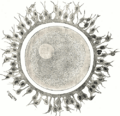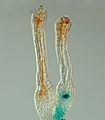Ovum facts for kids
An ovum (say "OH-vum") is the scientific name for a female reproductive cell. It's often called an "egg" cell. The plural of ovum is ova (say "OH-vah"). These tiny cells are super important because they carry half of the genetic information needed to create a new living thing. Both animals and plants make ova. An ovum is a special type of cell called a gamete, which means it's involved in sexual reproduction.
Contents
Mammal Reproduction
Human Life Cycle
In humans, ova are made and released by a female's ovaries. A female is born with all the egg cells she will ever have. Starting around puberty, usually once a month, one egg cell is released from an ovary. This process continues until a female reaches menopause, when no more eggs are released. The process of making and releasing eggs is called oogenesis.
When an ovum is fertilized by a male's sperm cell, it becomes a zygote. This zygote then starts to develop into a new organism. In humans, the ovum is fertilized inside the female's body. The developing embryo then grows inside the uterus, which is also called the womb. It gets food and oxygen from the mother through a special organ called the placenta.
The human ovum is the largest cell in the human body. It's so big that you can actually see it without needing a microscope! It measures about 100 to 200 micrometres across. Even though it's the largest human cell, it's much smaller than the eggs laid by animals like reptiles and birds. This is why human babies need to develop inside the mother's womb for a long time.
Other Mammals
The way reproduction works can be a bit different in other mammals. Female mammals are usually only ready to mate during a specific time called "heat." This "heat" period is when their ovaries release eggs, making them ready for fertilization.
Plant Reproduction
In many plants, like mosses and ferns, ova are made inside special structures called archegonia. This happens through a process called meiosis, which creates cells with half the usual number of chromosomes. An archegonium has a long "neck" with the egg cell inside. When the egg is ready, the neck opens up, and sperm cells can swim in to fertilize the egg.
In flowering plants, the female gametes are found inside a tiny part called the ovule. Inside the ovule is a structure called the embryo sac, which is made of only eight cells. The cell closest to the opening of the embryo sac becomes the egg cell. When pollination happens, sperm cells from pollen travel into the embryo sac and fertilize the egg. After fertilization, the zygote then grows into an embryo right inside the ovule.
Gallery
Images for kids
-
Gene expression pattern determined by histochemical GUS assays in Physcomitrella patens. The Polycomb gene FIE is expressed (blue) in unfertilized egg cells of the moss Physcomitrella patens (right) and expression ceases after fertilization in the developing diploid sporophyte (left). In situ GUS staining of two female sex organs (archegonia) of a transgenic plant expressing a translational fusion of FIE-uidA under control of the native FIE promoter
Related pages
See also
 In Spanish: Óvulo para niños
In Spanish: Óvulo para niños






